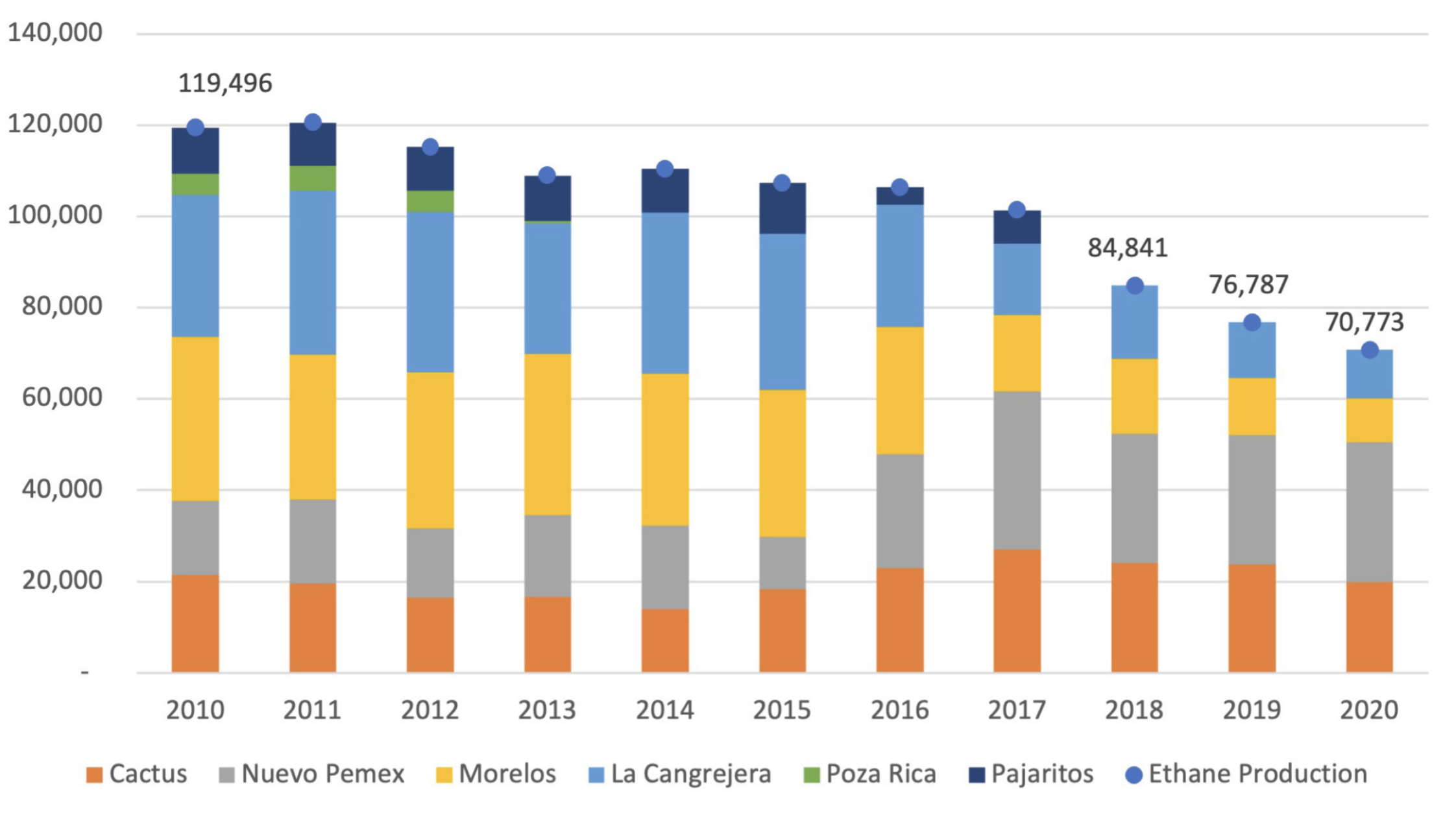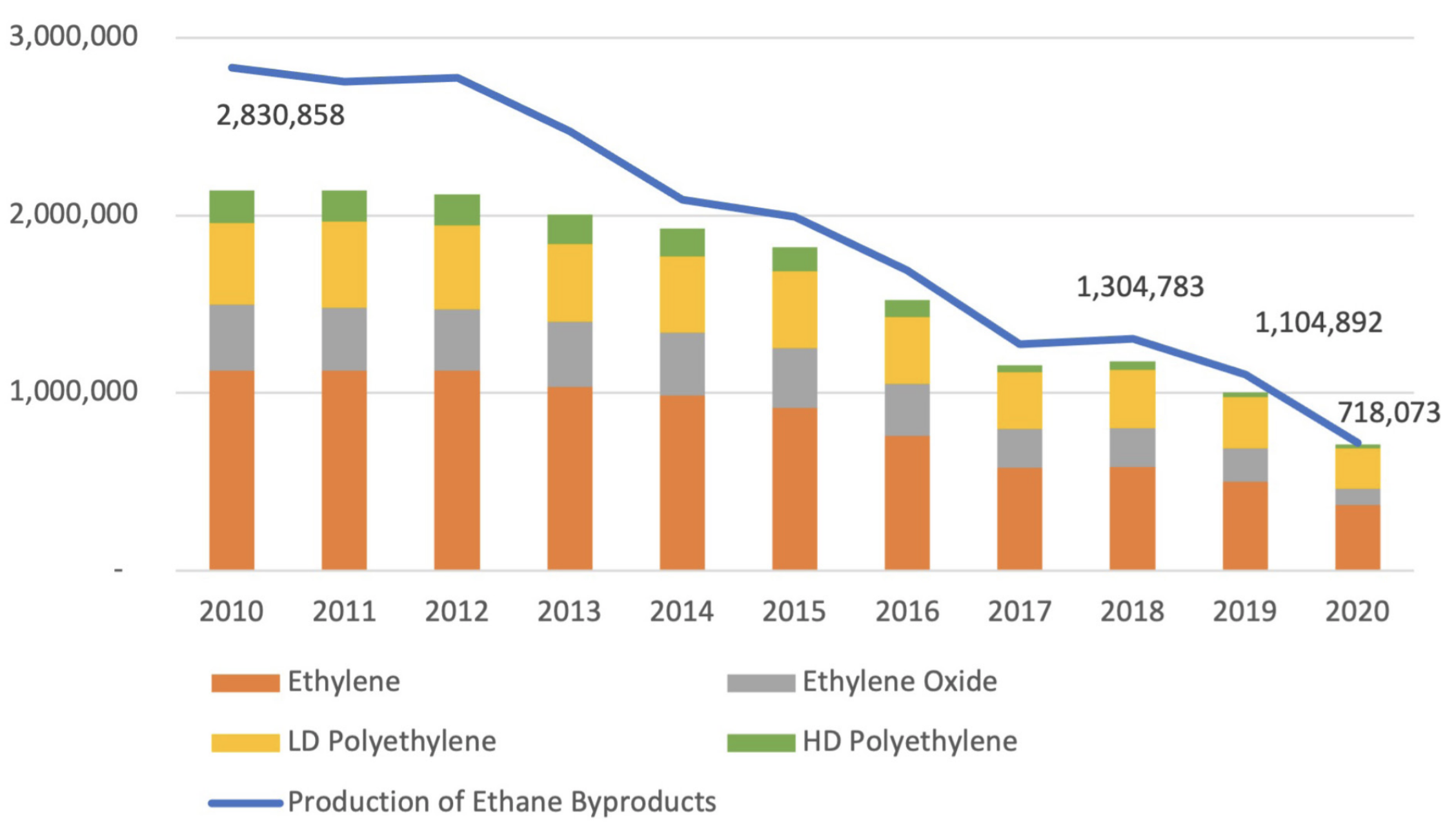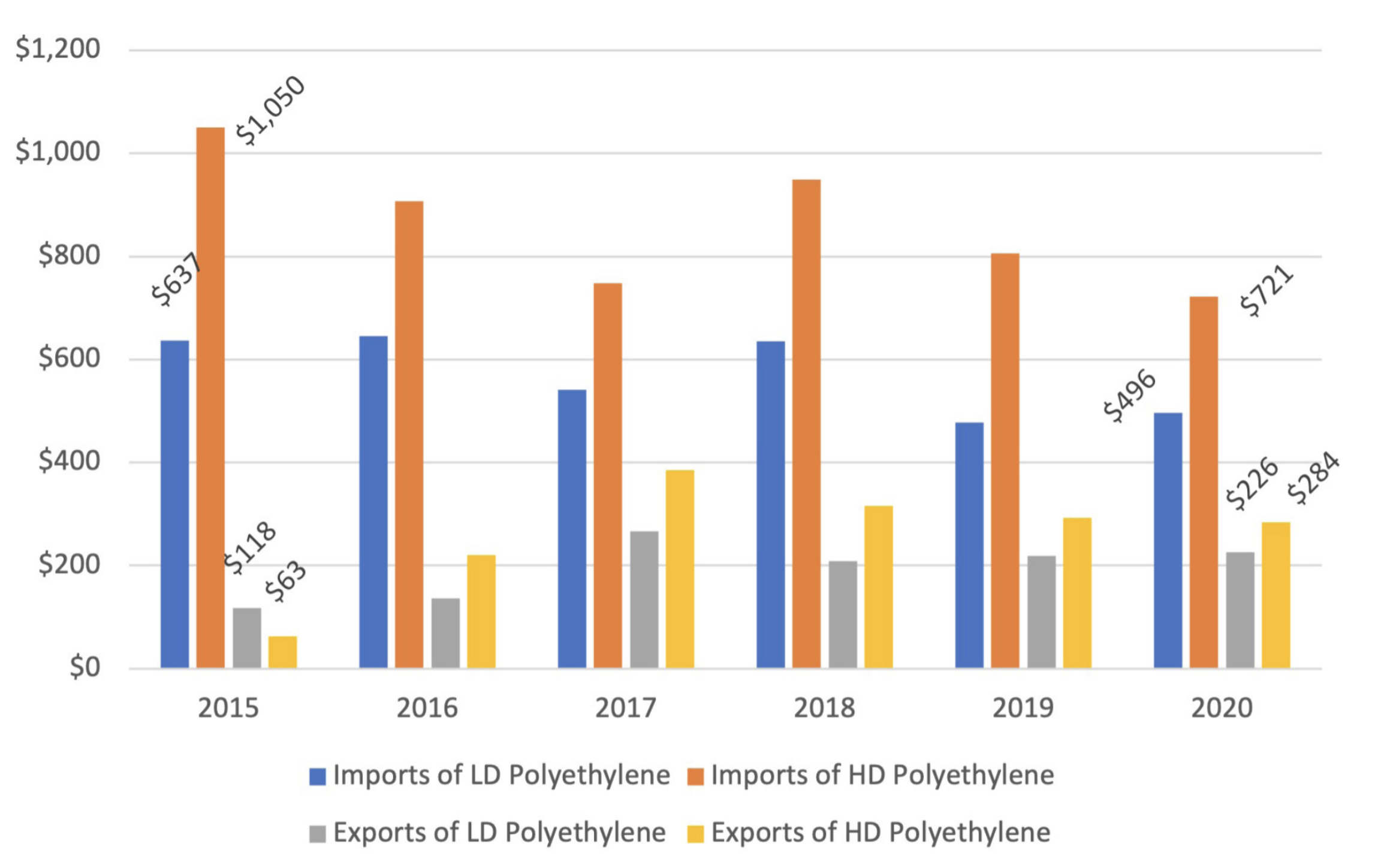The Value of Ethane Supply in Mexico

Table of Contents
Author(s)
Adrian Duhalt
Former Nonresident Scholar in Mexico Energy StudiesShare this Publication
- Download PDF
- Print This Publication
- Cite This Publication Copy Citation
Duhalt, Adrian. 2021. The Value of Ethane Supply in Mexico. Issue brief no. 04.14.21. Rice University’s Baker Institute for Public Policy, Houston, Texas.
The havoc wreaked by the outbreak of COVID-19 has thrown the world economy into a tailspin. Global gross domestic product (GDP) is forecasted to shrink by 3.5% in 2020.1 And Mexico stands as one the countries hardest hit, as its real GDP plunged by 8.5% on a year-to-year basis.2
The extent of the contraction is associated with the size of the fiscal stimulus package put in place by President Andrés Manuel López Obrador to alleviate the negative impact of the pandemic. Mexico earmarked only 0.7% of its GDP to that end, the lowest percentage of all G20 countries.3 But public spending is only part of the equation. Private investment is also needed if Mexico is to experience a robust economic recovery in 2021 and beyond.
The lack of spending also includes Mexico’s hydrocarbon sector, as the López Obrador government has decided to shelve new private investment in strategic activities where Petróleos Mexicanos (PEMEX) is the main player—i.e., oil and gas exploration and production—while failing, for example, to launch a plan to boost petrochemical activities, where PEMEX is ostensibly open to the participation of private firms.
In particular, investment in ethane production/supply could spark a positive economic spillover. As the most important feedstock for Mexico’s petrochemical industry, ethane is able to boost production of petrochemical by-products such as ethylene and polyethylenes by both PEMEX and private companies and as such, contribute to the much-needed economic rebound in the years to come.
What Is the Importance of Ethane?
Ethane is the most important chemical precursor in Mexico and boasts the capacity to induce an outpouring of financial resources that would eventually stimulate economic growth. It can be transformed into ethylene, and then into intermediate petrochemical products like ethylene oxide, polyethylenes, or vinyl chloride, and into final products such as automotive brake fluids, antifreeze, and household/industrial cleaners, or polyester fibers in others.4 As such, production of ethane can have positive economic effects and trigger investment far beyond locality as it culminates in the manufacture of a wide variety of final products we all consume on daily basis, from plastics in vehicles to food packaging and textiles, produced all across Mexico.
Figure 1 — Ethane Production at PEMEX Processing Centers, 2010-20205 (in Barrels per Day)

The drop in ethane production is part of a broader issue with respect to the Mexican government’s management of PEMEX over the years: focusing on short-term gains while taking little—if any—interest in a long-term approach. Figures 1 and 2 show that the approach of the current administration does not differ significantly from its predecessors, at least in the case of natural gas and petrochemicals, and may be even worse.
Figure 2 — PEMEX Production of Ethane Byproducts 2010-2020 (in Tons)6

Hence, the importance of ethane lies not only in its production but also—and critically so—in its transformation, that is, in the sequence of value-adding activities that are required to take it from its production to the final user or consumer.
Mexico does not need to look further than across its northern neighbor to see the value of ethane supply and its transformation. Over the past decade, increasing U.S. shale natural gas and oil production prompted a considerable upsurge in the U.S. production of natural gas liquids, in particular ethane, which skyrocketed from 869,000 barrels per day (bpd) in 2010 to 1,829,000 bpd in 2019. Consequently, this bountiful and inexpensive supply of ethane ignited new capital and expansion investments in the chemical/ petrochemical industry that, as of February 2021, amounted to $209 billion,7 with the U.S. Gulf Coast as the epicenter of this wave of capacity additions.8
To some extent, Mexico too offers evidence supporting the value of ethane supply. The decline in domestic production and the lack of suitable infrastructure to import and store it have had multiple consequences, such as lower utilization capacity rates at both state-owned and private user plants such as Etileno XXI.
The long-standing policy of prioritizing crude production has paid off in the form of revenues for Mexico’s government, but this line of reasoning has prevailed at the expense of other areas such as production of natural gas liquids and petrochemicals, where PEMEX could use a long-term strategy of development and growth. Consequently, ethane supply has progressively declined over the past decade, tumbling from an average of 119,496 bpd in 2010 to 70,773 bpd in 2020 (Figure 1).
PEMEX and Beyond
At PEMEX, ethane feeds the productive processes of its petrochemical complexes situated in southern Veracruz, whose production has been on a downward trajectory as well. Official estimates show that PEMEX produced 718,073 tons of ethane derivatives in 2020, down from 1,304,783 tons in 2018 and 2,830,858 tons in 2010.9 This is despite the López Obrador administration’s vow to revitalize PEMEX’s petrochemical production.
The drop in ethane production over the past decade (Figure 1) has brought a series of setbacks that go beyond its impact on the national oil company. In addition to falling production of by-products such as ethylene at state-owned facilities, the rise of imports10 and the weakening of associated economic activities (e.g., private user firms) are also among the detrimental consequences. Put together, the gap between domestic production and demand seems more harmful than one might anticipate and adverse conditions more complicated to overturn.
With PEMEX investment priorities focused elsewhere, petrochemical imports continue to fill the gap in the local market. Per Mexico’s Central Bank (Banxico), the value of imports of petrochemical products (precursors) and products of petrochemical origin (textiles, plastics, intermediate chemicals) have persistently remained high. While in 2010 that value amounted to $17.7 billion,11 in 2019 imports increased to $21.5 billion.12 And according to the United Nations International Trade Statistics Database, Mexico procured plastics and articles thereof (including ethane by-products) abroad to the tune of $24.6 billion in 2019, up from $17.4 billion in 2010.13
From an industry-wide perspective, the import numbers demonstrate that disregarding both ethane production and the transformation of hydrocarbons into high-value petrochemicals have been harmful for both PEMEX and the country’s industrial apparatus. As for the latter, this adverse context could not be illustrated better than by Etileno XXI, a $5.2 billion petrochemical joint venture between Brazil’s Braskem and Mexico’s Idesa.
Etileno XXI—the only private polyethylene producer—began operations in 2016 at the southern edge of the state of Veracruz, adjacent to the polyethylene plants of PEMEX.14 This project, regarded as the most important petrochemical investment in Mexico in at least three decades, uses ethane to feed plants that boast a capacity to yield up to 1,050,000 tons of polyethylenes.15 The timing of the project’s operation and trade deficit data indicate that production16 is one of the major elements contributing in recent years to the narrowing of Mexico’s polyethylene trade deficit, from $1,506 million in 2015 to $697 million in 2020. According to government estimates, from 2015 to 2020, Mexico’s imports of LD polyethylene decreased from $637 million to $496 million, and so did those of HD polyethylene, from $1,050 million to $721 million. Exports also went up during the same period, from $118 million to $226 million in the case of LD polyethylene and from $63 million to $284 million for HD polyethylene (Figure 3).17
Figure 3 — Value of Mexico's Polyethylene Trade, 2015-2019 (in Millions of U.S. Dollars)

In addition, a much broader set of economic gains could materialize before long. Given that the supply of ethane has been compromised as a result of falling production at PEMEX (the only domestic producer), Braskem-Idesa contemplates the construction of an import terminal at the port of Coatzacoalcos, a stone’s throw from its own polyethylene complex and those of PEMEX. The company foresees that thanks to an investment of close to $200 million, the terminal could allow imports of up to 50,000 barrels per day of ethane in the medium term.18 This suggests that, once in operation, the relentless supply concerns that have plagued private and PEMEX petrochemical complexes in past years could come to an end, which in turn would help increase production of ethane byproducts (including polyethylenes), fill the gap in the domestic market, and reduce imports.
This is testament to the potential of the private sector to help reverse the deterioration of the petrochemical industry and a lesson for PEMEX and for the Mexican government to encourage private activity in the petrochemical sector while looking at long-term scenarios when setting up PEMEX’s activities.
But what would it take for both the administration of López Obrador and other private firms to replicate the experience in this and other areas of the petrochemical industry, such as methane derivatives and aromatics? Given the financial constraints faced by PEMEX19 and the government and the degree of deterioration of state-owned petrochemical complexes, a public-private partnership of some sort is worth exploring. No such prospects are in sight.
Conclusion
The supply of ethane is one of the current administration’s pending issues. In light of the economic slowdown Mexico has faced in 2019 and 2020 and the much-needed recovery in 2021 and beyond, as indicated above, ethane production—given its role as a petrochemical precursor—could generate positive spillovers across a broader economic landscape.
López Obrador is frequently skeptical of private investment, but addressing the supply of ethane could help him find appreciation for teaming up with private players as path toward strengthening other value chains of the petrochemical industry and, potentially, other economic sectors.
Endnotes
1. In its October 2020 World Economic Outlook, the International Monetary Fund estimated global growth contraction for 2020 at -4.4%. See International Monetary Fund (IMF), World Economic Outlook Update, January 2021, https://bit.ly/2OwAV3b.
2. National Institute of Statistics and Geography (INEGI), “Timely estimation of gross domestic product in Mexico,” press release, January 29, 2021, https://bit.ly/3uA1LaA.
3. Saudi Arabia, second to last in the G20 list of countries, put in place a stimulus package worth 3.4% of its GDP. See Statista, Value of Covid-19 fiscal stimulus package in G20 countries as of October 2020, as a share of GDP, https://bit.ly/2Horr6l.
4. American Chemistry Council, “Facts about ethylene oxide,” November 2, 2020, https://bit.ly/3oPsvjS.
5. SIE (Mexico’s Energy Information System), “Natural gas liquids processed by center,” 2010-2020.
6. SIE, “Production of petrochemical products at Pemex,” 2010-2020.
7. This refers to completed, ongoing, and potential chemical industry projects announced as of February 2021. See American Chemistry Council, “Infographic: Economic impacts of shale gas,” February 2021, https://bit.ly/3q87yRb.
8. In a 2018 series of articles in the Houston Chronicle, the value of investment linked to abundant and affordable ethane supply was put at $140 billion. See Jordan Blum, “How the ethane molecule changed the Gulf Coast–and the world,” Houston Chronicle, September 14, 2018, https://bit.ly/2W9Xr23.
9. Overall production of ethane by-products refers to ethylene, ethylene oxide, LD polyethylene, LLD polyethylene, HD polyethylene, vinyl chloride, glycols, and dichloroethane.
10. This refers to ethane byproducts and plastics and articles thereof.
11. In fact, imports began to grow earlier. The value is reported at $7.4 billion in 2000 and at $10.3 billion in 2004. See Mexico’s Central Bank (Banxico), Economic Information System, Historical series of petrochemicals trade balance, https://bit.ly/3cAv4Dd.
12. 2020 imports amounted to $18.7 billion, a lower value vis-à-vis 2019 as a result of the outbreak of COVID-19. Mexico’s Central Bank (Banxico), Economic Information System, 2019 and 2020 petrochemicals trade balance, https://bit.ly/3uI4wGV.
13. 2019 figures are the latest reported. See United Nations International Trade Statistics Database (UN Comtrade Database), Value of Mexico’s imports of plastics and articles thereof, https://comtrade.un.org/data/.
14. In 2010, Braskem-Idesa entered into a 20-year contract with PEMEX to secure the supply of 66,000 barrels per day of ethane. But as production fell, PEMEX has been frequently unable to supply the agreed volume. The 2010 contract contemplated penalties if Pemex failed to supply said volume to Braskem-Idesa. Since assuming office, President López Obrador has deemed this and other terms unfavorable for PEMEX and stated his intention to renegotiate the contract. On March 3, 2021, both parties signed a memorandum of understanding that modifies the terms of the 2010 contract, which now sets the volume to be supplied by PEMEX at 33,000 bpd until 2024 and frees Pemex from further obligations after that year. See Petróleos Mexicanos, “PEMEX signs memorandum of understanding with Braskem-Idesa,” press release 64, March 3, 2021, https://bit.ly/3kPPNp4.
15. Braskem has a 75% stake in the project while Idesa has 25%. See Braskem Idesa, company profile, accessed on February 28, 2021, http://braskemidesa.com.mx/perfil.
16. Production figures in tons per year are not reported by Braskem-Idesa. Instead, the company reports capacity utilization rates per quarter, which helps us deduce that production has increased since 2016.
17. Mexico’s Tariff Information System via Internet (SIAVI), “Low density and high density polyethylene trade,” accessed on March 8, 2021, http://www.economia-snci.gob.mx/.
18. Braskem-Idesa, Investors’ presentation, March 2021, https://bit.ly/3cnk9vk.
19. PEMEX overall liabilities stand at $217.8 billion, of which $113.2 billion correspond to total consolidated financial debt and $76.9 billion to employee benefits, as of December 31, 2020. See PEMEX, Unaudited financial results reports, 4Q2020, https://bit.ly/2Qer6r1.
This material may be quoted or reproduced without prior permission, provided appropriate credit is given to the author and Rice University’s Baker Institute for Public Policy. The views expressed herein are those of the individual author(s), and do not necessarily represent the views of Rice University’s Baker Institute for Public Policy.


